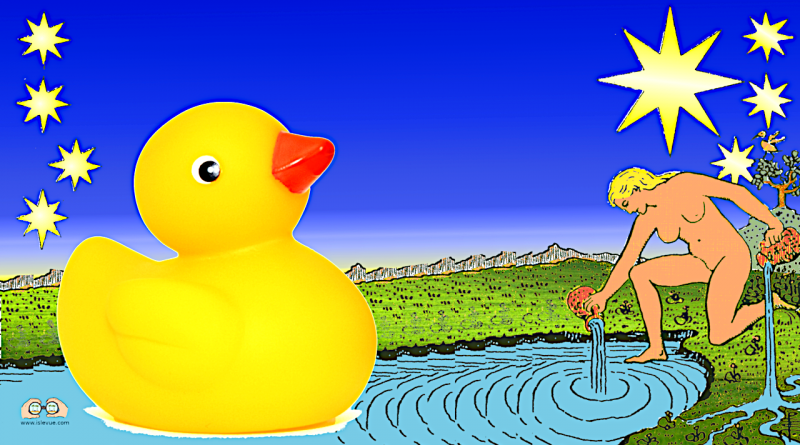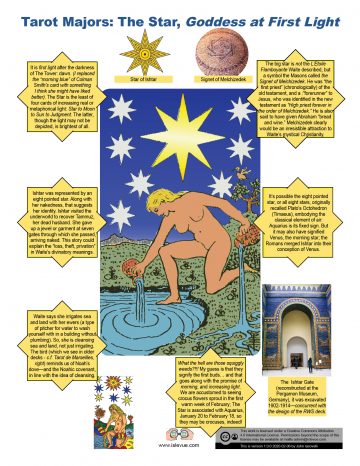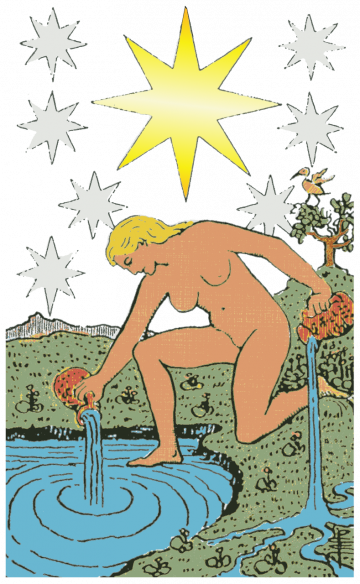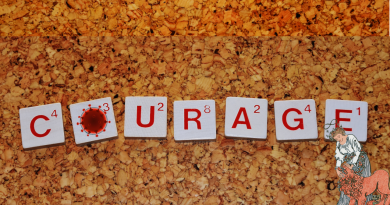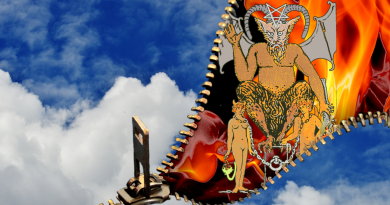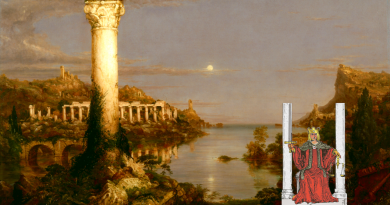The Star, Goddess at First Light
You’ve got to hand it to Pamela Colman Smith on this one. She took a not-very-attractive card from the Tarot de Marseilles (and older decks), and without substituting any major new elements, turned it into one of the prettiest cards in the RWS deck.
But new or old look, The Star raises many questions. Who is she? What Star in particular? Why eight points on the star? Why eight stars? The Star may very well be the least acccessible (on its surface) major arcanum.
The post expands upon a format—one page, one basic thought—depicting a single aspect of a single major arcanum. In this particular case, I have a bit more to say regarding The Star, and have put the “basics” in the one page piece, but have expanded these thoughts greatly in this article, including a few words addressing how this topic affected Waite’s divinatory meanings for this card. The PDF (see the link below) will be easier to read than the bitmap to the right, by the way.
Why a Duck?
Its order among the majors is the first clue. The Star is the first light card following the dark backgrounds of The Devil and The Tower. Moreover we see a bird in a tree. Though it looks more like a plucked duck than a rooster crowing the dawn, it is a clear signal of the time of day, since that is when the birds wake and sing.
Robert M. Place traces many of the identities and the order of the major arcana to the triumphal pageants of northern Italy in the renaissance, and to Petrarch’s poem Triumphs. (I have to confess that I only just skimmed it in preparation for this post; I’m more of a Dante kind of guy, I guess).
In the poem, there is no Tower, but after Death, Petrarch tells us the time is dawn: “in the sullen rear of night, Before the golden wheels of orient light He came.” Fame is the next in the parade. This is probably consistent with our calling a famous person a “star” today. In fact the Oxford English Dictionary cites the first English usage (18th century) in that respect as that of a lead performer outshining his fellow performers who were “little stars.” This is a startlingly apt comparison. Wikipedia states:
Death departs and after Death comes Fame. Her appearance is compared to the dawn. She is attended by Scipio and Caesar, and many other figures from Rome’s military history, as well as Hannibal, Alexander, Saladin, King Arthur, heroes from Homer’s epics, and patriarchs from the Hebrew scriptures. Accompanying these soldiers and generals are the thinkers and orators of Classical Greece and Rome. It has been remarked that for Petrarch, Plato is a greater philosopher than Aristotle, who was preferred by Dante.
So fame looks like the Dawn. Waite says of the figure in Colman Smith’s illustration, “she is in reality the Great Mother in the Kabalistic Sephira Binah, which is supernal.” Mathers (in The Tarot, 1888) said, pre-Colman Smith, “A nude female figure pours water upon the earth from two vases. In the heavens above her shines the Blazing Star of the Magi (surrounded by seven others), trees and plants grow beneath her magic influence (and on one the butterfly of Psyche alights). She is the star of Hope.”
Both Waite and Mathers give us abstract concepts; much different than the Fame of Petrach, who seems to like to name names. But if we take Mathers’ clue, by which he names the big, eight-pointed star, we might yet come to understand this card better.
Waite also describes it as the Masonic l’étoile flamboyante, which not only was no longer in use by the masons by the time Waite, wrote, but actually had either seven (the liberal arts) or five (points of fellowship) rays! 19th century masons did have an eight pointed star they called the Signet of Melchizedek. It was not widely used; it is probable, however, that Waite was referring to it.
As per Wikipedia, “In Christianity, according to the Epistle to the Hebrews, Jesus Christ is identified as “High priest forever in the order of Melchizedek”, and so Jesus assumes the role of High Priest once and for all.” In fact,
Another interesting thing about Melchizedek is that he knew Abraham, and Melchizedek is said to have proclaimed that God gave Abraham a tenth of mankind to form the seven tribes of Israel. Though I think it unlikely, it is possible that seven smaller stars represent those tribes. We can also note that some texts speak of Melchizedek giving “bread and wine” to Abraham; another irresistible Jesus link for Waite’s mystical Christianity, no doubt. Melchizedek is the first step on the path to Jesus, explaining the early time of day. The Star of Bethlehem links to Jesus’ birth, which brings the Virgin Mary into the picture. It would be an explanation understandable to owners of the early tarot decks (where the figure was sometimes dressed in expensive clothes). But given the nudity of the Tarot de Marseilles figure, it is probably impossible to make the link to Mary. Melchizedek can explain the eight pointed stars, but not the figure.
In the early illustrations, it is quite possible that the eight pointed stars, and indeed, all eight stars, also recall Plato’s Octohedron (Timaeus), which represents the classical element of air; after all, Aquarius is the fixed sign of Air. Plato theorized that air was composed of particles shaped like two pyramids glued together at their bottom sides. The Pythagorean school additionally held that there are in man eight organs of knowledge; sense, fantasy, art, opinion, prudence, science, wisdom, and mind.
We now have a wealth of possible explanations for the eight pointed, eight stars. Too many, in fact. None of them, however, explain the identity of the figure. Waite also says of her “She pours Water of Life from two great ewers, irrigating sea and land.” A ewer is a specific type of pitcher, usually accompanied by a basin, so that you can wash yourself in a building without running water. Therefore, though Waite says she irrigates sea and land, she is, moreover, cleansing it.
In this respect, the bird in the tree reminds us of Noah’s dove. We have seen two other cards regarding the first covenant, with Noah, and the second covenant, that of Jesus, represented by the rainbow. This would be something easily understood by the general public in earlier times.
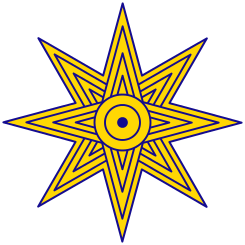
But there may be another story that fits eight pointed star, water and bird. The ancient Mesopotamians used an eight pointed star to represent Ishtar. In fact, the nakedness of Colman Smith’s goddess might confirm her identity as Ishtar/Inanna. According to one story she descended to the underworld to recover Tammuz, her husband who died young. She gives up one each of her jewels or garments at seven gates through which she has to pass, arriving naked, finally losing her memory of self. This story could easily serve as the foundation for the “loss, theft, privation” in Waite’s divinatory meanings. Nothing in the story of Noah, Bethlehem and Jesus could point to that so well. Ishtar regained her memory after another god sent someone without fear to bathe her in the water of life. And the bird could represent Irkalla, Queen of the Underworld, a chimera god with some of the characteristics of a bird. The Ishtar Gate was excavated 1902-1914, so Ishtar would have been quite au courant at the time of the creation of the Waite Colman Smith tarot deck. The rediscovery of Sumeria, and of Gilgamesh, when Smith was a young man, with English translations of the German translations appearing in the three decades starting in the 1880’s caused a sensation because the Sumerian writings were the first third party references to events such as the great flood in the Hebrew bible.
Ishtar, the Queen of Heaven, who was later rolled into Isis and Venus would certainly serve as a good model for the “supernal mother.” And therein lies a solution for the big star and its seven sister stars, still visible, hovering over the dawn horizon. Venus is the morning star. The seven other stars may represent the seven planets (in effect counting Venus twice, of course). When is the best time to observe the planets? At dusk and dawn.
I cannot let myself sum up and draw lessons for modern readers without looking at one other thing that always draws my attention in the RWS Star: what the hell are all those squiggly weeds in the grass?!!! My guess is that they signify the first buds… and that goes together with the promise of increasing light. We are accustomed to seeing crocus flowers sprout in the first warm week of February; Aquarius covers January 20 to February 18, so they may be exactly that!
To wrap it up, then:
- Whether it be the neoplatonist battle of light vs. darkness, the star of Bethlehem or the prophecy of Melchizedek, it’s dawn. This card portrays the arrival of light, and the promise of more. It is not just the faint light of a star (or the morning star), it is that daylight, whether it be the bright light of the Sun or the Son, is about to arrive. This is the first of the four great cards of increasing light—Star, Moon, Sun, Judgment—with the latter the most brilliant of all, metaphorically speaking.
- Whether Ishtar/Venus, the Virgin Mary or a representation of Binah, she combines the divine feminine, the creativity associated with a beginning, and some form of purity, whether associated with cleansing or a virgin state to begin with. And in fact, I believe Waite and Colman Smith probably meant for The Star to represent all three: Ishtar, Mary and Binah.
- As such the divinatory meanings for this card should properly be seen through the context of the goddess/saintly figures. On the one hand it is the loss of husband or son, as with Ishtar and Mary; on the other it is the hope and prospects of the mother for her child. We explicitly see these in Waite’s upright divinatory meanings: “Loss, theft, privation, abandonment; another reading says – hope and bright prospects.”
In a modern reading, what all this tells us that in seeing this card, we need to not just say that it is simply about hope, but that it may have something to do with the querent’s relationship (or loss of relationship) with someone, mother or otherwise, who is to them what the divine feminine is, i.e., the bringer of love, light and promise of a bright day. It should recall to the querent those women who have influenced the querent’s own qualities of creation, intuition, community and sensuality.
So in the end, it doesn’t matter who The Star is, it’s whose mother The Star is. Waite was right in his own way, but Colman Smith aced him. Again.
Copyright Information:The article above is copyright ©2020 by John Iacovelli, All rights reserved.
 The content of the downloadable one page “Tarot Majors” document, also by John Iacovelli, for islevue.com is licensed under a Creative Commons Attribution 4.0 International License. Permissions beyond the scope of this license may be available at mailto:admin@islevue.com.
The content of the downloadable one page “Tarot Majors” document, also by John Iacovelli, for islevue.com is licensed under a Creative Commons Attribution 4.0 International License. Permissions beyond the scope of this license may be available at mailto:admin@islevue.com.
Final note: the feature image collage may have generated some interest. No copyrighted sources were used in its composition. If there is further interest, I’ll stick a Creative Commons license in it and make a very high resolution version available somewhere.
